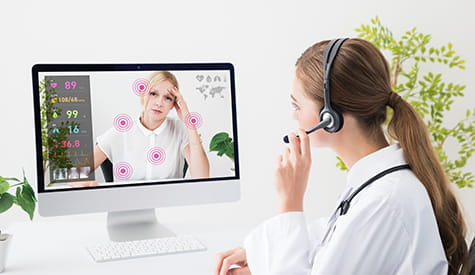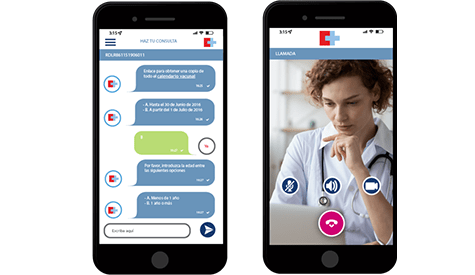SCS enhances citizens’ mobile application with teleconsultation, enabling 6,000 healthcare professionals to optimize care delivery.

The recent health crisis unleashed mayhem around the world, but nowhere was it more concentrated than in the healthcare industry. While other workers adjusted to the new work from home norm, healthcare workers found themselves in the eye of the storm.
Cantabrian Health Service (SCS), the public health agency in the Cantabrian region of Spain was challenged with the task of providing healthcare, and preventive health and rehabilitation for its 583,000 citizens in the midst of the chaos of the day.
SCS understood that it would be increasingly difficult to provide access to medical professionals during a pandemic. To address this unprecedented situation they implemented a Communications Platform as a Service (CPaaS) strategy as a way to maintain continuity of patient care with a focus on telemedicine. They knew that virtual care, powered by CPaaS technology, could provide an opportunity to reduce the strain on their already over-extended healthcare systems. CPaaS has enabled 6,000 caregivers in hospitals, care centers, and medical inspection services to provide efficient consultations and optimize care delivery. As well, remote consultations help to minimize the spread of infection and foster stronger patient-caregiver relationships.
What exactly is CPaaS?
In simple terms, a Communications Platform as a Service is a cloud-based application platform that provides a comprehensive development framework for integrating real-time communications and collaboration capabilities (for example phone, chat, video, and file sharing) into business applications.
For SCS, CPaaS provides a highly customisable platform that combines automation and chatbots for simple queries and it can hand-off patients to a human agent for a voice or video consultation when necessary. CPaaS technology allows SCS to engage with their patients remotely using digital technology that is both simple and secure for the patient and the clinician.
So what’s the difference between CPaaS and a consumer platform?
Well, prior to CPaaS, real-time communications were only possible using the call button on your smartphone. For example, you might have a healthcare app on your smartphone, but when you need to talk to a healthcare professional, you have to call a hospital phone number. You can't make a WhatsApp or FaceTime call to your doctor!
But, what if you could video chat with a doctor directly in your healthcare app?
This is where CPaaS is different. It provides the tools for developers to add real-time communication features into other applications, such as a patient application, medical record applications, or appointment systems, and most importantly it can be done without having to build a complex backend infrastructure or interface.
The power of CPaaS
As one of its requirements, SCS wanted to increase digital engagement and improve its citizens’ accessibility to health services from their smartphones. To alleviate pressure on the healthcare system and their staff, SCS provided patients with the SCSalud mobile app, which gives them the ability to make appointments, access health card details, obtain a list of health centers, identify on-duty pharmacies, access frequently asked questions, and more.
SCS also quickly recognized the many capabilities provided by the CPaaS approach, including the ability to customise developments offered by the Rainbow™ by Alcatel-Lucent Enterprise platform to enrich the SCSalud application with new use cases.
The first use case defined provided citizens with the ability to get expert health advice using chat, and have questions answered by a chatbot about vaccinations and health centers opening hours. In addition, for more serious cases, they could access voice communications, and secure video teleconsultations with healthcare professionals throughout the Cantabrian region.
The image below on the left shows an example of a chat in the SCSalud application. The image on the right shows a video call from a doctor during a teleconsultation.

Following the successful adoption of the SCSalud application by more than 136,000 citizens, the oncology department is moving forward with a second use case. The requirement is to embed real-time communications, in the form of videoconferencing between physicians, directly into the oncology platform. Bahia Software have easily integrated the Rainbow CPaaS API into the physicians' appointment calendar. The ability to initiate conferences between physicians and multiple patients directly from the business application allows them to better collaborate and gain efficiencies in care delivery.
Cantabrian Health Service have demonstrated the power of Rainbow CPaaS as a digital enabler across the entire healthcare system. The platform, software development kits, and libraries for PC/MAC, iOS and Android smartphone allow developers to easily and securely add real-time communications features (including chat, chatbot, voice, and video) directly into existing medical applications as well as patient-citizen apps or almost any other application.
Learn all about ALE Healthcare solutions.
Latest Blogs
Supply chain resilience and business adaptability
Strategic supply chain resilience and business adaptability to thrive in the face of adversity
Solve education challenges with a modern campus network
A modern campus network helps streamline operations, reduce costs, and offers a safe and caring place to work and study.
Revitalise education with a modern campus network
A modern, campus-wide network upgrade aligns capabilities with academic, research and business priorities today and tomorrow.
Education today: Why modernising campus networks is a must
Educational institutions worldwide must modernise their networks to meet today’s new requirements.

